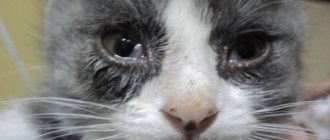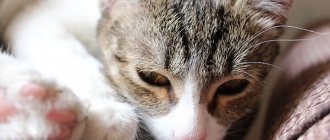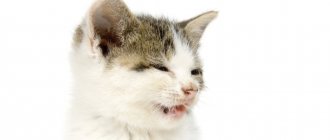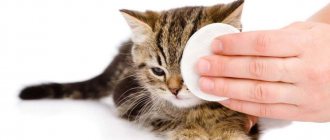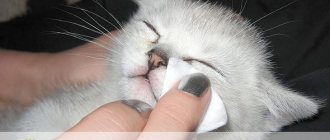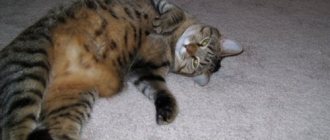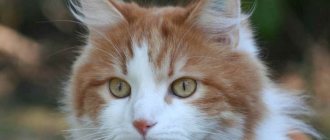Why does a cat sneeze, have watery eyes or a stuffy nose: causes and symptoms
Sneezing occurs for a number of reasons.
Why does a cat sneeze and his eyes water?
The most common of them is inhalation of dust, which leads to irritation of the mucous membrane. But sometimes this sign, combined with lacrimation, is one of the signs of a pathological process.
Possible reasons:
- Allergy. If your pet has an allergic reaction, it can be recognized by frequent sneezing. This is especially true after direct contact with the allergen. Additional signs: skin rash, shortness of breath, vomiting.
- Cold. When the body is hypothermic, in addition to the main symptoms, there is nasal discharge, fever, and cough.
- Infectious pathologies. The cause of development is fungi, bacteria, infections. Symptoms of diseases can vary dramatically, but there are also common signs: weakness, apathy, lack of interest in food and games, upset bowel movements, mucous discharge from the eyes.
- Foreign body stuck in the nose. Cats can get fine gravel, insects, blades of grass, and more in their noses. In this case, the sneezing is constant, hiccups are constantly rubbing the nose with the paw. Additional symptoms: restless behavior, difficulty breathing, and in some cases, bleeding from the nose.
- Polyps. Formations in the nose can also provoke sneezing, which is combined with heavy discharge, as well as snoring.
- Asthma. Additional signs include difficulty breathing, hoarseness, weakness, apathy, and attempts to swallow air.
- Oncology. This reason is extremely rare. In addition to general symptoms, the presence of malignant tumors can be recognized by bleeding, excessive lacrimation, sudden weight loss, and loss of smell.
- Internal parasites. When worms infect the respiratory system, symptoms similar to a cold also appear. The presence of parasites can be recognized by the depressed state of the cat, hair loss in clumps, sudden weight loss, and intestinal dysfunction.
Be sure to read:
Discharge from the eyes in cats: normal or pathological, causes, what to do, treatment and prevention
Tips for beginners when washing eyes
Eye washing is one of the most important points in the treatment and prevention of disease in any animal.
You can do the procedure yourself at home or go to a veterinary clinic. During a period of illness, a cat is most often reluctant to allow its owner to approach it.
Recommendations:
- A folded cotton pad or a tight tourniquet is suitable for rinsing. It is better to avoid cotton swabs, as they do not absorb liquid well, have a relatively small surface and can damage the retina when the animal tries to escape.
- For sterility purposes, it is better to prepare separate dishes for washing each eye. For the same reason, you should use a cotton pad no more than once.
- It is not recommended to touch the inflamed surface with a dry disc.
- Hands must be washed.
- All solutions must be at room temperature.
- Keep in mind that a swollen area can often cause pain for your cat.
- The best treatment is comprehensive. After rinsing with the solution/drops, re-treat the inflamed area with ointment.
- You need to repeat washing as often as possible. Step-by-step instructions for washing eyes
- Fix the animal on its side, turning its head up, holding the chin.
- If a crust forms and the eye sticks together, soften the inflamed area with Vaseline oil. Using cotton wool soaked in 3% hydrogen peroxide, remove the discharge, then rinse with the solution and apply eye drops.
- Apply the solution to the eyeball, gently lifting the eyelids.
- Raise and lower the animal's eyelids several times to distribute the medication evenly. Remove excess with a disc.
- Do not forget about nasal discharge, remove it with a cotton pad.
Main problems
There are many conditions characterized by sneezing and watery eyes, but some are diagnosed more often than others. It is worth considering them separately. If other significant symptoms are present, pathology can be identified and treated.
How to tell if your cat has a cold
The cause of the disease is hypothermia of the pet. This is facilitated by a sharp temperature change. To do this, your pet just needs to play actively and then go outside during the cold season.
Swimming in cold water, jumping in the snow, and staying in the rain also contribute to the development of colds.
Characteristic features:
- cough;
- lethargy;
- conjunctivitis;
- temperature increase, but insignificant;
- lack of interest in food;
- snot.
Important! Cold symptoms are in many ways similar to other more serious pathologies, and if in doubt, you should visit a veterinarian and clarify the diagnosis.
To recover, you need to provide your pet with peace, warmth and rest. It is recommended to periodically wash your eyes and nose with a cotton swab dipped in clean water at a comfortable temperature.
If the provoking factor is reduced immunity, then it is recommended to use vitamins and immunomodulators as agreed by the veterinarian. A cold goes away within 5-7 days.
Symptoms of laryngitis
The disease is characterized by inflammation of the mucous membrane of the mouth and larynx.
The cause of development is hypothermia of the throat
The cause of development is hypothermia of the throat as a result of eating cold food from the refrigerator or water, as well as after a long stay outside in winter or exposure to acrid smoke.
Symptoms:
- dry, hysterical cough, gradually turning into a wet one;
- swelling of the oral mucosa;
- foamy discharge from the mouth after a prolonged cough;
- restless sleep;
- wheezing.
To treat laryngitis, various medications are used depending on the cause of development. Only a veterinarian will prescribe an adequate course of therapy.
Attention! Laryngitis can be a sign of deadly viruses such as rabies, so you should see a doctor if these symptoms appear.
Rhinitis in cats
Rhinitis in cats
The pathological process develops against the background of hypothermia, allergies, parasites and various infections. At the same time, the cat has difficulty breathing and constantly opens his mouth.
Additional symptoms:
- inflamed lymph nodes under the jaw;
- sniffling;
- snore;
- dyspnea;
- snort;
- decreased activity;
- lack of appetite.
It is impossible to try to treat rhinitis without knowing the cause of its occurrence. This threatens to significantly complicate the situation and deteriorate the pet’s well-being. To prescribe therapy, consultation with a veterinarian is necessary.
Be sure to read:
A kitten's eyes are watering: what to do, reasons, norm and pathology, characteristics of different breeds
Sinusitis in cats
Development is caused by a viral or bacterial infection. Sinusitis appears against the background of sinusitis. Mucus accumulates in the maxillary sinuses, and when infection occurs, suppuration occurs.
First signs:
- rubbing the nose with a paw;
- purulent mucus from the nose with an unpleasant odor;
- food preferences change (the cat prefers liquid and warm food);
- mouth breathing;
- the temperature rises by 1-3 degrees.
If sinusitis is suspected, the animal must be taken to a veterinarian and a series of tests must be carried out to confirm the disease.
Treatment is carried out with antibiotics, and in advanced cases, trepanation is used with washing the sinuses with disinfectant solutions.
Allergy
Sneezing and watery eyes may be an allergic reaction . Allergy triggers are often pollen, industrial feed, animal care products, dust, etc.
Sneezing and watery eyes may be an allergic reaction
It is important that the owner can track why the cat developed unpleasant symptoms. This will prevent contact with the allergen.
In the advanced form, additional symptoms appear in the form of:
- vomiting;
- swelling of the mucous membrane;
- skin itching;
- scratching the nose with a paw.
For treatment, antihistamines are used, which are administered orally or intramuscularly.
Polyp formation
Polyps in a cat can be either congenital or acquired due to an untreated allergy or infection. Symptoms may not appear immediately, but as the tumor grows, the pet begins to experience discomfort.
Additional signs:
- snore;
- mouth breathing;
- weight loss;
- head shaking;
- discharge from the ear;
- lack of coordination;
- depressed state.
Polyps are removed surgically. Then a course of antibiotics and corticosteroids is prescribed to prevent the inflammatory process.
Asthma
The suspected cause of asthma is allergies. The disease can be recognized by a paroxysmal dry cough and shortness of breath.
The appearance of unpleasant symptoms can also be caused by other pathologies. But only an experienced specialist can make an accurate diagnosis.
The priority treatment drugs are hormonal agents in the form of tablets, injections, and sprays. Additionally, bronchodilators are prescribed, used during attacks to expand the patency of the bronchi.
Other possible causes of runny nose and sneezing
The appearance of unpleasant symptoms can also be caused by other pathologies. But only an experienced specialist can make an accurate diagnosis.
Other provoking factors:
- foreign object;
- chlamydia;
- viral leukemia;
- immunodeficiency virus
- dental diseases.
Prevention
In order for your cat to suffer less from infectious diseases, you need to monitor his immune system and get vaccinations on time. Kittens are vaccinated at eighteen months of age with an interval of 2 to 4 weeks. This helps strengthen the body and prevents illness throughout the year. Adult cats need vaccinations annually. This will make them less likely to sneeze and prevent them from coughing.
Preventive measures against allergies include the following:
- monitor the cleanliness of the cat’s personal belongings and sleeping area;
- remove the cat’s access to irritants;
- monitor your pet's food - give only what the veterinarian recommends;
- apply insecticides.
There is no need to panic ahead of time if the eyes are watery and your pet is constantly sneezing. It could just be a cold. But, of course, it never hurts to visit a doctor once again to find out the exact cause of the disease.
https://youtube.com/watch?v=_f7JN2cIdrI
Correct diagnosis and treatment of possible diseases
The effectiveness of therapy directly depends on the correctness of the diagnosis. To identify pathology, it is important that the owner is able to determine why the pet developed unpleasant symptoms.
The more information the pet owner provides, the faster a diagnosis will be made.
What to look for when making a diagnosis
Even before visiting a doctor, you can assume a diagnosis based on your observations. This will significantly narrow the list of suspected diseases.
Be sure to read:
What to do if pus comes out of your cat’s nose, what could it be, should you be afraid?
If sneezing is rare, but at the same time there is profuse lacrimation, and mucus is flowing, the eyes are swollen and breathing is difficult, then an allergy is presumably to blame.
When general symptoms are combined with fever, swollen tonsils and green mucus, we can conclude that there is an infection. If sneezing is accompanied by bad breath, your pet may have dental problems.
What to do if a kitten sneezes and its eyes fester?
In case of purulent exudate, it is recommended to wash the pet’s eyes with a weak solution of boric acid or furatsilin 3 times a day.
As part of complex therapy, the antibiotics Maxidin and Fosprenil are used to reduce the inflammatory process, as well as the drugs Gamavit and Baksin, which strengthen the immune system.
What to do if your kitten starts sneezing frequently and has watery eyes
Watery eyes appear with colds and allergies. In the first case, it is enough to wash your eyes three times a day with furatsilin, instill drops for a runny nose and provide complete rest to your pet. And in the second case, contact with the allergen should be prevented and antihistamines should be used.
In what cases is a visit to the veterinarian necessary?
If the discomfort is caused by a virus, then it is difficult to cope with the pathology on your own. Any delay can be dangerous for the pet's life.
Signs when you should not put off a visit to the veterinarian:
- severe swelling of the oral mucosa, impairing breathing;
- bleeding;
- fever against a background of general apathy and loss of strength;
- copious discharge of pus from the eyes and ears;
- wheezing and whistling when inhaling and exhaling;
- digestive disorders, making it impossible to eat.
You should also visit a veterinarian if the cat was picked up from the street and needs vaccinations.
What can you do at home?
Here's how you can help your cat:
Ensure a comfortable temperature in the room where the cat lives, because overheating, like hypothermia, has a negative effect on its body
It is also important to avoid low humidity, since in this case the pet’s mucous membranes dry out and cease to protect the animal from bacteria and dust. As a result, pathogens penetrate the body faster. Avoid dehydration, which often occurs when the temperature rises and the cat completely refuses water.
The owner will have to force-feed the pet from a syringe. If it is not possible to get him to drink in this way, it is allowed to administer saline or Ringer's solution intravenously. Force feed your pet if it refuses food for 3 days or more. You can offer your cat food that is not too heavy: high-quality wet food, finely chopped boiled chicken liver, low-fat broth, cottage cheese. In addition, you can try to stimulate your cat's appetite with food with a distinct smell. Introduce vitamins into your pet's diet. It is better to give preference to drugs in the form of injections, since the absorption of nutrients at this time is reduced. Use only those medications prescribed by your doctor to treat your cat.
Worm infestations
Worm infestations that constantly threaten cats can cause sneezing: toxoplasmosis, dirofilariasis.
In the acute form of toxoplasmosis, the cat becomes lethargic, refuses to eat, has a high body temperature, coughing, sneezing, runny nose, lacrimation, shortness of breath, and heavy wheezing breathing. When the nervous system is involved in the pathological process, the cat develops convulsions, muscle tremors, twitching, and in severe cases, paralysis. Sometimes there is a disturbance in the functioning of the gastrointestinal tract (vomiting, diarrhea, constipation). If the liver is damaged, there is an icteric discoloration of the visible mucous membranes. More details about toxoplasmosis in the article – toxoplasmosis in cats.
Dirofilariasis (heart parasites transmitted by mosquito bites) develops in the heart muscle and leads to sneezing, dry cough, shortness of breath similar to asthma, increased fatigue, weight loss, heart failure, upon auscultation - heart murmurs, rapid heartbeat. Read more about this disease in our article - dirofilariasis.
Preventive actions
As they say, it is better to prevent a disease than to cure it. Various preventive measures will help you avoid troubles such as sneezing and snot in your cat. One of the effective measures is vaccination! If you regularly carry out examinations and give your cat vaccinations, you can avoid allergies and other diseases of this kind. So don’t delay getting vaccinated.
Here is a list of diseases for which a cat needs regular vaccination:
- Rabies.
- Leukemia.
- Cat flu and various viral infections.
Let your pet live a fulfilling and healthy life. Do not spread illnesses , maintain hygiene and pay attention to the slightest deviation from your usual state. Give love and daily, monthly, and annual care. Prevention is better than cure. Believe me, nothing human is alien to our pets. And they also want to be strong, well-groomed, healthy and attractive to the opposite sex. So give them this opportunity!
